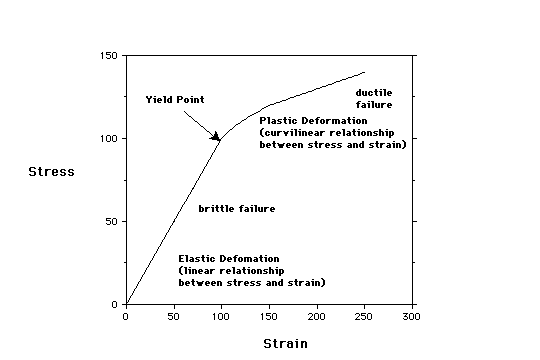Several experiments can be done to illustrate the behavior of material subjected to a stress - a directed force. For example, you can pull on both ends of a rubber band. If you pull just a little and then let go, the rubber band returns to its original length. The rubber band has behaved elastically.
If you pull much further and then let go you may find that the rubber band has "stretched" and is actually longer than when you started. The rubber band has behaved plastically. The stretching action (pulling or tension) is the stress and the change in length is the strain.
If you keep pulling on the rubber band it will eventually fail (break) or rupture and return to an unstressed position. Stretching stores energy in the object and rupture releases it. If the object fails after behaving plastically it is said to have failed in a ductile fashion. Some materials fail before plastic behavior sets in; this is brittle failure. If you hit the rubber band with a hammer it will deform and rapidly recover its predeformed shape. If you put the rubber band in the ice box for several hours it will probably shatter (brittle) when it is hit.
Get a piece of gum or a bar of "Turkish Taffy -if they make it anymore and "play with it....". Stand it up vertically - what happens? Bend it ....what happens? Cool it off and hit it....what happens? Or, try the same things with silly putty.
Not all materials behave the same way. As the pressure increases (deeper burial) the material may change the way it behaves. For example, many rocks become stronger at higher pressures. Sometimes the rate at which the stress is applied (fast versus slow) makes a difference in the type of behavior. Some become weaker as the temperature increases.
A plot of stress versus strain is given below:

In this stress-strain plot note that when the plot is linear the behavior is elastic. When the plot is curved the behavior is plastic. Elastic strain is recoverable whereas deformation produced by plastic flow is not - a permanent change in shape results. The yield point is the point where elastic behavior stops and plastic behavior begins.
An object may deform elastically but not recover immediately when the stress is relieved; in other words there is a delayed reaction. 10,000' of ice (almost 2 miles) exerts considerable force on the surface it is flowing over. When the ice melts it may take a considerable time (thousands of years, perhaps) for the surface to regain its initial elevation - elastic rebound.
In addition to tensile behavior (pulling) rocks will deform when they are pushed together - compression. When we talk about structural geology we will look in more detail at elastic and plastic behavior of Earth materials. In this section we are primarily concerned with what happens when a rock fails and energy is released.
When the "strength of the rock" is exceeded it fails - either in a brittle or ductile fashion. The Dilatancy Model predicts that rocks undergo an increase in volume just before they rupture. Small cracks begin to form. Water may enter these cracks and increase the fluid pressure which further increases the volume of the rock and decreases its strength until rupture takes place. Energy is released and it "propagates" in all directions away from the "point" (focus) where the break occurred. The depth to the focal point is an important piece of information about the quake. Recall, for example, that Earthquakes along mid-ocean ridges are quite shallow whereas those along a subduction zone may be quite deep. If you draw a line from the center of the Earth through the focus and extend it to the surface, the epicenter is the point of intersection of the line with the Earth's surface; the epicenter is the point on the surface closest to the focus.